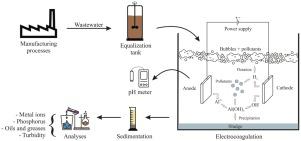当前位置:
X-MOL 学术
›
Process Saf. Environ. Prot.
›
论文详情
Our official English website, www.x-mol.net, welcomes your
feedback! (Note: you will need to create a separate account there.)
Treatment of automotive industry wastewater by electrocoagulation using commercial aluminum electrodes
Process Safety and Environmental Protection ( IF 6.9 ) Pub Date : 2020-10-01 , DOI: 10.1016/j.psep.2020.06.029 Lucas Pandolphi Zini , Marielen Longhi , Eliena Jonko , Marcelo Giovanela
Process Safety and Environmental Protection ( IF 6.9 ) Pub Date : 2020-10-01 , DOI: 10.1016/j.psep.2020.06.029 Lucas Pandolphi Zini , Marielen Longhi , Eliena Jonko , Marcelo Giovanela

|
Abstract Industrial liquid wastes may cause serious damage to nature and human health. Taking into account the protection of water resources and, especially, compliance to current legislation and international standards, several technologies for wastewater treatment have been studied. In general, the physico-chemical treatment is well-established and is applied by most industries. Electrocoagulation (EC) is a wastewater treatment method that has been evaluated as a procedure that may replace conventional treatment and significantly reduce the amount of sludge produced. Within this context, this work aimed to apply EC to the treatment of an industrial liquid waste from an automotive company to assess the efficiency of the technique. The industrial wastewater was collected, treated, and analyzed with regard to some discharge standards, including phosphorus, oils and greases, pH, turbidity, and metals (Al, Cr, Fe, Mn, and Zn). Moreover, the wear of aluminum electrodes used in the process, the electricity consumption, and compliance with the discharge standards were also evaluated. In general, either the removal efficiency or the reduction of discharge parameters was proportional to time and electric current density, but only one set of applied parameters met all limits. Electric current efficiencies exceeded 150 %, indicating that the wear of electrodes surpassed the estimate provided by Faraday’s law. In addition, the electricity consumption increased proportionally to the time and electric current density with a loss of energy as heat.
中文翻译:

使用商用铝电极通过电凝聚处理汽车工业废水
摘要 工业废液可能对自然和人类健康造成严重危害。考虑到水资源的保护,特别是遵守现行立法和国际标准,研究了几种废水处理技术。总的来说,物理化学处理已经很成熟并且被大多数行业应用。电凝聚 (EC) 是一种废水处理方法,已被评估为可以取代常规处理并显着减少产生的污泥量的程序。在此背景下,这项工作旨在将 EC 应用于汽车公司的工业液体废物的处理,以评估该技术的效率。对工业废水按部分排放标准进行收集、处理和分析,包括磷、油和油脂、pH、浊度和金属(Al、Cr、Fe、Mn 和 Zn)。此外,还评估了过程中使用的铝电极的磨损、电力消耗和排放标准的遵守情况。一般来说,去除效率或放电参数的减少与时间和电流密度成正比,但只有一组应用参数满足所有限制。电流效率超过 150%,表明电极的磨损超过了法拉第定律提供的估计值。此外,电力消耗与时间和电流密度成正比增加,能量损失为热量。还评估了电力消耗和排放标准的遵守情况。一般来说,去除效率或放电参数的减少与时间和电流密度成正比,但只有一组应用参数满足所有限制。电流效率超过 150%,表明电极的磨损超过了法拉第定律提供的估计值。此外,电力消耗与时间和电流密度成正比增加,能量损失为热量。还评估了电力消耗和排放标准的遵守情况。一般来说,去除效率或放电参数的减少与时间和电流密度成正比,但只有一组应用参数满足所有限制。电流效率超过 150%,表明电极的磨损超过了法拉第定律提供的估计值。此外,电力消耗与时间和电流密度成正比增加,能量损失为热量。电流效率超过 150%,表明电极的磨损超过了法拉第定律提供的估计值。此外,电力消耗与时间和电流密度成正比增加,能量损失为热量。电流效率超过 150%,表明电极的磨损超过了法拉第定律提供的估计值。此外,电力消耗与时间和电流密度成正比增加,能量损失为热量。
更新日期:2020-10-01
中文翻译:

使用商用铝电极通过电凝聚处理汽车工业废水
摘要 工业废液可能对自然和人类健康造成严重危害。考虑到水资源的保护,特别是遵守现行立法和国际标准,研究了几种废水处理技术。总的来说,物理化学处理已经很成熟并且被大多数行业应用。电凝聚 (EC) 是一种废水处理方法,已被评估为可以取代常规处理并显着减少产生的污泥量的程序。在此背景下,这项工作旨在将 EC 应用于汽车公司的工业液体废物的处理,以评估该技术的效率。对工业废水按部分排放标准进行收集、处理和分析,包括磷、油和油脂、pH、浊度和金属(Al、Cr、Fe、Mn 和 Zn)。此外,还评估了过程中使用的铝电极的磨损、电力消耗和排放标准的遵守情况。一般来说,去除效率或放电参数的减少与时间和电流密度成正比,但只有一组应用参数满足所有限制。电流效率超过 150%,表明电极的磨损超过了法拉第定律提供的估计值。此外,电力消耗与时间和电流密度成正比增加,能量损失为热量。还评估了电力消耗和排放标准的遵守情况。一般来说,去除效率或放电参数的减少与时间和电流密度成正比,但只有一组应用参数满足所有限制。电流效率超过 150%,表明电极的磨损超过了法拉第定律提供的估计值。此外,电力消耗与时间和电流密度成正比增加,能量损失为热量。还评估了电力消耗和排放标准的遵守情况。一般来说,去除效率或放电参数的减少与时间和电流密度成正比,但只有一组应用参数满足所有限制。电流效率超过 150%,表明电极的磨损超过了法拉第定律提供的估计值。此外,电力消耗与时间和电流密度成正比增加,能量损失为热量。电流效率超过 150%,表明电极的磨损超过了法拉第定律提供的估计值。此外,电力消耗与时间和电流密度成正比增加,能量损失为热量。电流效率超过 150%,表明电极的磨损超过了法拉第定律提供的估计值。此外,电力消耗与时间和电流密度成正比增加,能量损失为热量。











































 京公网安备 11010802027423号
京公网安备 11010802027423号